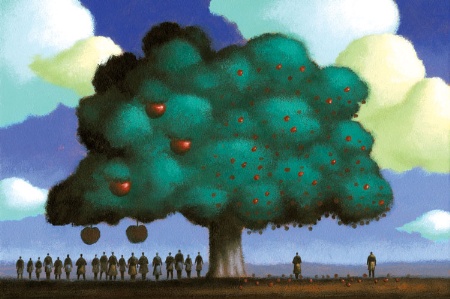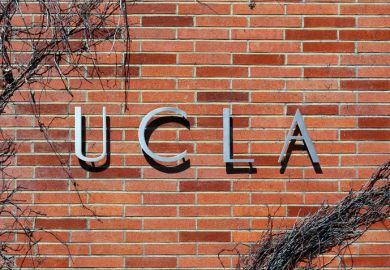Source: James Fryer
Faculty are dominantly found where students haven’t been for decades or where they are leaving in droves. Some departments have more academic staff than students taking majors
Trustees of Dartmouth College v Woodward was a landmark 1819 decision from the United States Supreme Court that arose when the New Hampshire legislature attempted to force Dartmouth to become a public institution. When Dartmouth hired an alumnus, Daniel Webster, to argue the case against the change, he famously stated that it was “a small college and yet there are those who love it”. To this day there are many who still love the not-so-small college on the hill, which now has just over 6,000 students and 1,000 faculty. Historically, the Ivy League institution ranks behind only Princeton University when it comes to the percentage of undergraduate alumni who donate, with Princeton at 58 per cent to Dartmouth’s 56 per cent. With a green and leafy campus, Dartmouth also owns and manages ,000 acres of woodland in northern New Hampshire, which was given by the state of New Hampshire in 1807. As of 30 June 2013, the value of its endowment stood at $3.73 billion (£2.21 billion).
The private not-for-profit institution, where I have worked since 1989, makes an interesting case study. Of particular note is the fact that the current cost of study, including board, for 2014-15, is just over $65,000 a year. The admissions policy is needs-blind and there are no sports or merit scholarships (which tend to benefit the wealthy). Free tuition is provided for students from families with total incomes of $100,000 or less and possessing typical assets, and $82 million in needs-based scholarships is distributed to Dartmouth students annually. The average scholarship for the Class of 2017 is more than $41,380. Inevitably, student quality, measured by SAT and ACT scores, is exceptionally high. Thirty per cent of students who declare their rank are valedictorians (students who came top of their class in high school) and 10 per cent salutatorians (the second highest graduate) and half are from ethnic minority groups.
As part of their liberal arts education, students at Dartmouth have to complete 35 courses across a broad range of subjects to ensure that there are no innumerate humanists or illiterate scientists – as often exist in the UK with its system of early specialisation. These classes include a writing class, a first-year seminar, a language and a study of world culture as well as 10 distributive requirements. Every student must study one course in each of the following areas: the arts; literature; systems and traditions of thought, meaning and value; international or comparative study; quantitative and deductive sciences and technology or applied science; and two courses in social analysis and two in the natural sciences. One course must have a laboratory, fieldwork or experimental component. Students must also complete a programme of physical education – including a mandatory swimming test.
Finally, students have to complete a major. Students are free to choose whatever major they like once admitted, but there is the rub. The problem is that they speak with their feet and seem to well understand rates of return – the earning power associated with different degrees – whether they or their parents are paying, and especially if they are on a “free ride”.
Dartmouth, along with the other Ivies, ends up with most of its students crammed into three majors – pre-med, pre-law and pre-wealth – because they want to be a doctor, a lawyer or to work on Wall Street. So the economics, government, biology and psychology/neuroscience departments at Dartmouth are flooded with students. Majors in economics have risen from 134 to 210 in just over a decade (see table). Biology has more than doubled. Government saw increases through 2011-12, although, as the market for young lawyers has tightened, enrolments appear to have diminished. Class sizes in these departments are large and many classes have waiting lists.
There is also evidence that students are gravitating towards harder subjects. When economics toughened the criteria for its major, more students showed up. Disciplines such as neuroscience, engineering and maths have seen increases and the proportion of students also doing a minor in these subjects is up from per cent to 31 per cent in five years. Of the 15 departments that awarded the highest grades to students at Dartmouth in 2013, eight were languages while the toughest graders were economics, biology and chemistry. Not only do the humanities and interdisciplinary departments give higher grades than science and social science departments, but the gap is growing: the difference in grade point average scores has changed from about 0.2 in 2001 to about 0.26 in 2013. Lower student enrolments equal higher grades. Meanwhile, in assessments of teaching, academics achieve the highest scores in the best research departments – precisely the ones flooded with students.
When some go up, others must come down, given that the total number of majors at Dartmouth has remained at about 1,060 over the past decade. So the humanities have seen a substantial decline, with the number of majors dropping from 289 to 214 (about the same number as in the economics department in 2012-13). Either departments had students a decade ago (English, philosophy and religion, for example) and lost them, or they didn’t have students and they still don’t (such as German, Russian and theatre).
But that generates a major resource allocation problem, especially in terms of faculty, who are dominantly found in departments where the students haven’t been for decades (such as Russian) or where students are leaving in droves (English). Some departments now have more academic staff than students taking majors. The humanities division has 182 full-time faculty, down from 189 (a 4 per cent drop) in 2008-09. Meanwhile, the number of social science faculty has risen from 123 to 133 (an 8 per cent increase) in the same period as the number of majors in social science rose by 12 per cent. The humanities division now has approximately five times as many faculty as the economics department, yet both teach the same number of majors. Something is wrong here.
Academic staff are in exactly the wrong places to fit the new student demands in a world of high tuition fees; previous administrations allocated faculty incorrectly to where there were few students or where student demand was about to fall (the reasons for this are unclear). A random allocation based on the drawing of lots or throwing darts at a dartboard would have been a better way to allocate faculty. Just like macroeconomists who mostly failed to spot the Great Recession, forecasting models of student demand have been fundamentally flawed.

An obvious fix is to raise the price of an economics degree, or to lower the price for one in the humanities, or both, in order to encourage more students to major in the humanities
Understandably, students make different choices when education is free or when total costs are more than a quarter of a million dollars. Any attempt to change the patterns described here will take time, but what are the options?
An obvious fix is to raise the price of an economics degree, or to lower the price for one in the humanities, or both, in order to encourage more students to major in the humanities.
Dartmouth could also decide to recruit students directly to a subject area, rather than allowing them to major in any subject once they have been admitted. That potentially could ease some enrolment pressures but it might be hard to resist pleadings to change major once admitted.
It is potentially possible to design new majors that students really want and, as far as is feasible, to move existing resources there. Computational or “big data” approaches come to mind as areas likely to attract students. Students could be taught to crunch big numbers in the sciences and social sciences, and even in the humanities, making the disciplines more appealing to earnings-aware students. Technology studies, which could span a number of different disciplines, would be a conceptually valuable as well as eminently practical major. Many Dartmouth students want Silicon Valley as much as Wall Street, and understanding how people interact with technology is surely as relevant as understanding how people interact in groups (sociology) or cultures (anthropology).
Another possibility – a controversial one – would be to simply reduce the number of faculty in the humanities by increasing tenure and hiring standards dramatically and ensuring that retiring faculty are not replaced. Every advertised job is swamped with applicants. A hiring freeze and early retirement incentives are possibilities worth considering. The problem with pay freezes is that the best faculty would quit; they are the ones with options.
A more acceptable alternative that does not throttle the humanities would probably be to give academics working in these disciplines a wider role through teaching a broader range of humanities courses to students who are not taking a major in the humanities. Indeed, such an approach could be logical in financial terms, too, given the salaries paid to economics faculty in the US: the opportunity cost nowadays of a run-of-the-mill assistant professor in economics is nearly two really good assistant professors in English or philosophy.
Humanities professors could teach courses that non-majors might actually want – including help with writing compositions and studies of the “great books” – rather than 15th-century Serbian literature or whatever esoteric subject the professor happens to study.
At the same time, it makes sense to hire more faculty into growth areas such as economics. But then there are issues about how big a department of economics, say, you want, especially as it isn’t easy to hire economists when competing institutions have the same enrolment pressures. Does it make sense to have a huge economics department of 50 or even 100 faculty? Do you want half your students majoring in three or four subjects?
These trends at Dartmouth have wider implications. England, which has recently moved to a student “demand-led” system and higher fees, would do well to take note. In the US, there has been much discussion and angst about the declining proportion of bachelor’s degrees awarded in the humanities. At Dartmouth, even if present trends continue, there will always be a place for humanities scholars to teach classes for non-majors. That is not an option in England unless degrees are broadened so that scientists and social scientists take humanities classes. The worry is that humanities departments might struggle to find students of adequate quality, and lowering standards is unlikely to be a long-term fix.
You pays your money and you takes your choice, as the saying goes. The market, as always, will respond.
Rise and fall: subject and divisional changes
| Number of majors at Dartmouth by subject | 2001-02 | 2008-09 | 2011-12 | 2012-13 |
|---|---|---|---|---|
| Economics | 134 | 172 | 182 | 210 |
| Government | 109 | 132 | 145 | 125 |
| Psychology/neuroscience | 120 | 1 | 120 | 119 |
| History | 109 | 81 | 88 | 100 |
| Engineering sciences | 68 | 54 | 80 | 85 |
| Biology | 29 | 86 | 88 | 73 |
| English | 94 | 81 | 67 | 54 |
| Number of majors at Dartmouth by division | 2003-04 | 2008-09 | 2012-13 |
|---|---|---|---|
| Note: Students may have more than one major. Comparable data not available for all years. Source: Dartmouth Factbook | |||
| Number of students | 1,061 | 1,054 | 1,058 |
| Interdisciplinary | 89 | 135 | 102 |
| Humanities | 289 | 2 | 214 |
| Sciences | 7 | 266 | 9 |
| Social sciences | 573 | 582 | 650 |
| Completed majors | 1,228 | 1,255 | 1,245 |
Register to continue
Why register?
- Registration is free and only takes a moment
- Once registered, you can read 3 articles a month
- Sign up for our newsletter
Subscribe
Or subscribe for unlimited access to:
- Unlimited access to news, views, insights & reviews
- Digital editions
- Digital access to THE’s university and college rankings analysis
Already registered or a current subscriber? Login





